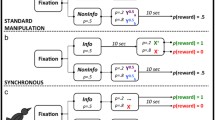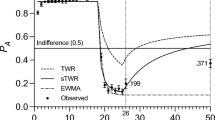Abstract
A general framework for analysing the effects of variability and the effects of interruptions on foraging is presented. The animal is characterised by its level of energetic reserves, x. We consider behaviour over a period of time [0,T]. A terminal reward function R(x) determines the expected future reproductive success of an animal with reserves x at time T. For any state x at a time in the period, we give the animal a choice between various options and then constrain it to follow a background strategy. The best option is the one that maximizes expected future reproductive success. Using this framework, we show that sensitivity to variability in amount of energy gained is logically distinct from sensitivity to variability in the time at which food is obtained. We also show that incorporating interruptions results in both a preference for variability in time and a preference for a reward followed by a delay as opposed to the same delay before the reward.
Similar content being viewed by others
References
Barnard, C.J., and Brown, C.A.J. (1985). Risk-sensitivity in foraging common shrews (Sorex araneus L.). -Behav. Ecol. Sociobiol. 16: 161–164.
Barnard, C.J., and Brown, C.A.J. (1985). Competition affects risk-sensitivity in foraging shrews. - Behav. Ecol. Sociobiol. 16: 379–382.
Barnard, C. J., Brown, C. A. J., Houston, A. T., and McNamara, J.M. (1985). Risk-sensitive foraging in common shrews: an interruption model and the effects of mean and variance in reward rate. - Behav. Ecol. Sociobiol. 18: 139–146.
Battalio, R.C., Kagel, J.H., and MacDonald, D.N. (1985). Animals' choices over uncertain outcomes: some initial experimental results. - Amer. Econ. Rev. 75: 597–613.
Bookstaber, R., and Langsam, J. (1985). On the optimality of coarse behavior rules. - J. theor. Biol. 116: 161–193.
Caraco, T. (1980). On foraging time allocation in a stochastic environment. - Ecology 61: 119–128.
Caraco, T. (1981). Energy budgets, risk and foraging preferences in dark-eyed juncos (Junco hyemalis). - Behav. Ecol. Sociobiol. 8: 213–217.
Caraco, T. (1982). Aspects of risk-aversion in foraging white-crowned sparrows. - Anim. Behav. 30: 719–727.
Caraco, T. (1983). White-crowned sparrows (Zonotrichia leucophrys) foraging preferences in a risky environment. -Behav. Ecol. Sociobiol. 12: 63–69.
Caraco, T., and Lima, S.L. (1985). Foraging juncos: interaction of reward mean and variability. - Anim. Behav. 33: 216–224.
Caraco, T., and Lima, S.L. (in press). Survivorship, energy budgets and foraging risk. - In M.L. Commons, A. Kacelnik and S.J. Shettleworth, eds., Quantitative analyses of behavior, vol. 6. Foraging. - New Jersey: Lawrence Erlbaum.
Caraco, T., Martindale, S., and Whittam, T.S. (1980). An empirical demonstration of risk-sensitive foraging preferences. - Anim. Behav. 28: 820–830.
Charnov, E.L. (1973). Optimal foraging - some theoretical explorations. - Ph.D. thesis, University of Washington.
Charnov, E.L. (1976). Optimal foraging: attack strategy of a mantid. - Am. Nat. 110: 141–151.
Charnov, E.L. (1976). Optimal foraging: the marginal value theorem. - Theor. Pop. Biol. 9: 129–136.
Clark, C.W., and Mangel, M. (in press). Unified foraging theory. - Ecology.
Davison, M.C. (1969). Preference for mixed-interval versus fixed-interval schedules.- J. Exp. Anal. Behav. 12: 247–252.
Davison, M.C. (1972). Preference for mixed-interval versus fixed-interval schedules: number of component intervals. J. Exp. Anal. Behav. 17: 169–176.
Dunn, R., and Fantino, E. (1982). Choice and the relative immediacy of reinforcement.- J. Exp. Anal. Behav. 38: 321–326.
Herrnstein, R.J. (1964). A periodicity as a factor in choice. - J. Exp. Anal. Behav. 7: 179–182.
Houston, A.I., Kacelnik, A., and McNamara, J.M. (1982). Some learning rules for acquiring information. - In D.J. McFarland, ed., Functional ontogeny, 140–191. - London: Pitman.
Houston, A.I., and McNamara, J.M. (1982). A sequential approach to risk-taking. - Anim. Behav. 30: 1260–1261.
Houston, A.I., and McNamara, J.M. (1985). The choice of two prey types that minimizes the probability of starvation. - Behav. Ecol. Sociobiol. 17: 135–141.
Houston, A.I., and McNamara, J.M. (1985). The variability of behaviour and constrained optimization. - J. theor. Biol. 112: 265–273.
Killeen, P. (1968). On the measurement of reinforcement frequency in the study of preference. - J. Exp. Anal. Behav. 11: 263–269.
Lea, S.E.G. (1979). Foraging and reinforcement schedules in the pigeon. Optimal and non-optimal aspects of choice. -Anim. Behav. 27: 875–886.
Lea, S.E.G. (1981). Correlation and contiguity in foraging behaviour. In P. Harzem and M.D. Zeiler, eds., Predictability, correlation and contiguity, 355–406. - Chicester: John Wiley.
Levanthal, A. M., Morrell, R. F., Morgan, E. J., and Perkins, C.C. (1959). The relation between mean reward and mean reinforcement. - J. Exp. Psych. 57: 284–287.
Logan, F.A. (1965). Decision-making by rats: uncertain outcome choices. - J. Comp. Physiol. Psych. 59: 246–251.
Logan, F.A. (1965). Decision-making by rats: delay versus amount of reward. - J. Comp. Physiol. Psych. 59: 1–12.
Logue, A.W., and Mazur, J.E. (1981). Maintenance of self-control acquired through a fading procedure: follow-up on Mazure and Logue (1978). - Behav. Anal. Lett. 1: 131–137.
Logue, A.W., Smith, M.E., and Rachlin, H. (1985). Sensitivity of pigeons to pre-reinforcement and postreinforcement delay. - Anim. Learn. Behav. 13: 181–186.
Mazur, J.E., and Logue, A.W. (1978). Choice in a “selfcontrol” paradigm: effects of a fading procedure. -J. Exp. Anal. Behav. 30: 11–17.
McDiarmid, C.G., and Rilling, M.E. (1965). Reinforcement delay and reinforcement rate as determinants of schedule preference. - Psychon Sc. 2: 195–196.
McNamara, J.M., and Houston, A.I. (1980). The application of statistical decision theory to animal behaviour. -J. theor. Biol. 85: 673–690.
McNamara, J.M., and Houston, A.I. (1982). Short-term behaviour and life-time fitness. In D.J. McFarland, ed., Functional ontogeny, 60–87. London: Pitman.
McNamara, J.M., and Houston, A.I. (1986).The common currency for behavioral decisions.- Am. Nat. 127: 358–378.
McNamara, J.M., and Houston, A.I. (in press). Partial preferences and foraging. - Anim. Behav.
Oster, G.F., and Wilson, E.O. (1978). Caste and ecology in the social insects. - Princeton: Princeton University Press.
Pubols, B.H. (1962). Constant versus variable delay of reinforcement. - J. Comp. Physiol. Psych. 55: 52–56.
Pyke, G.H. (1984). Optimal foraging theory: a critical review. - Ann. Rev. Ecol. Syst. 15: 523–575.
Real, L.A. (1980). Fitness, uncertainty, and the role of diversification in evolution and behavior.- Am. Nat. 115: 623–638.
Real, L.A. (1981). Uncertainty and pollinator-plant interactions: the foraging behavior of bees and wasps on artificial flowers. - Ecology 62: 20–26.
Real, L.A., Ott, J., and Silverfine, E. (1982). On the trade off between the mean and the variance in foraging: an experimental analysis with bumblebees. - Ecology 63: 1617–1623.
Shull, R.L., Spear, D.J., and Bryson, A.E. (1981). Delay or rate of food delivery as a determiner of response rate. - J. Exp. Anal. Behav. 35: 129–143.
Staddon, J.E.R.S., and Innis, N.K. (1966). Preference for fixed vs. variable amounts of reward. - Psychon. Sc. 4: 193–194.
Stephens, D.W. (1981). The logic of risk-sensitive foraging preferences. - Anim. Behav. 29: 628–629.
Stephens, D.W., and Charnov, E.L. (1982). Optimal foraging: some simple stochastic models. - Behav. Ecol. Sociobiol. 10: 251–263.
Waddington, K.D., Allen, T., and Heinrich, B. (1981). Floral preferences of bumblebees (Bombuz edwardsii) in relation to intermittent versus continuous rewards. - Anim. Behav. 29: 779–784.
Wunderle, J.M. Jr., and O'Brien, T.G. (1985). Risk aversion in hand-reared bananaquits. - Behav. Ecol. Sociobiol. 17: 371–380.
Young, J.S. (1981). Discrete-trial choice in pigeons: effects of reinforcer magnitude. - J. Exp. Anal. Behav. 35: 23–29.
Author information
Authors and Affiliations
Rights and permissions
About this article
Cite this article
McNamara, J.M., Houston, A.I. A general framework for understanding the effects of variability and interruptions on foraging behaviour. Acta Biotheor 36, 3–22 (1987). https://doi.org/10.1007/BF00159228
Received:
Issue Date:
DOI: https://doi.org/10.1007/BF00159228




